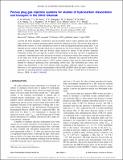Porous plug gas injection systems for studies of hydrocarbon dissociation and transport in the DIII-D tokamak
Author(s)
McLean, A. G.; Davis, J. W.; Stangeby, P. C.; Brooks, N. H.; Ellis, R. M.; Haasz, A. A.; Rudakov, D. L.; West, W. P.; Wong, C. P. C.; Whyte, Dennis G; ... Show more Show less
DownloadWhyte_Porous Plug.pdf (651.1Kb)
PUBLISHER_POLICY
Publisher Policy
Article is made available in accordance with the publisher's policy and may be subject to US copyright law. Please refer to the publisher's site for terms of use.
Terms of use
Metadata
Show full item recordAbstract
A probe has been designed, constructed, and successfully used to inject methane into the DIII-D lower divertor in a manner imitating natural release by chemical erosion. This porous plug injector (PPI) probe consists of a self-contained gas reservoir with an integrated pressure gauge and a 3 cm diameter porous surface through which gas is injected into the lower divertor of the tokamak. The probe is positioned flush with the divertor target surface by means of the divertor materials evaluation system. Two gas delivery systems were developed: in the first, gas flow is regulated by a remotely controlled microvalve and in the second by a fixed micro-orifice flow restrictor. Because of the large area of the porous surface through which gas is admitted, the injected hydrocarbon molecules see a local carbon surface (>90% carbon) similar to that seen by hydrocarbons being emitted by chemical sputtering from surrounding carbon tiles. The distributed gas source also reduces the disturbance to the local plasma while providing sufficient signal for spectroscopic detection. In situ spectroscopic measurements with the PPI in DIII-D allow the direct calibration of response for measured plasma conditions from a known influx of gas.
Date issued
2009-04Department
Massachusetts Institute of Technology. Department of Nuclear Science and Engineering; Massachusetts Institute of Technology. Plasma Science and Fusion CenterJournal
Review of Scientific Instruments
Publisher
American Institute of Physics
Citation
McLean, A. G. et al. “Porous plug gas injection systems for studies of hydrocarbon dissociation and transport in the DIII-D tokamak.” Review of Scientific Instruments 80 (2009): 043501.© 2009 American Institute of Physics
Version: Final published version
ISSN
0034-6748